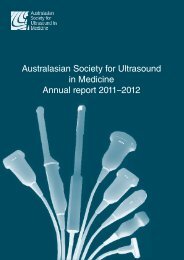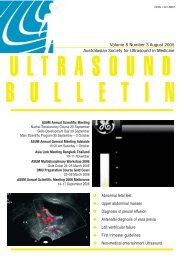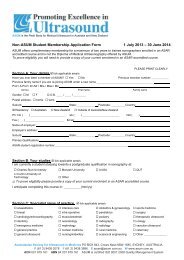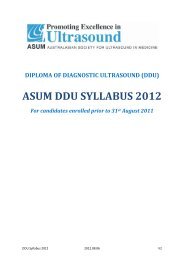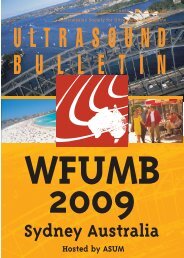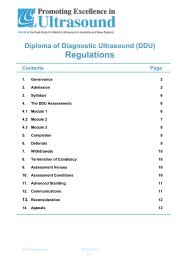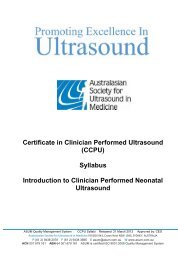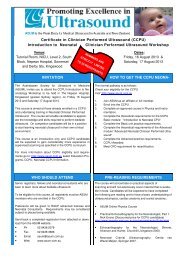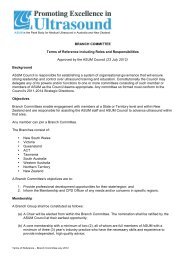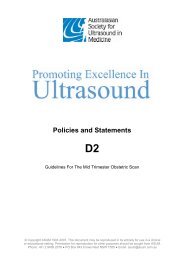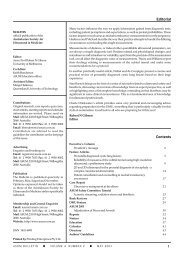DDU(Vascular) - Australasian Society for Ultrasound in Medicine
DDU(Vascular) - Australasian Society for Ultrasound in Medicine
DDU(Vascular) - Australasian Society for Ultrasound in Medicine
- No tags were found...
You also want an ePaper? Increase the reach of your titles
YUMPU automatically turns print PDFs into web optimized ePapers that Google loves.
<strong>DDU</strong>(<strong>Vascular</strong>) SyllabusLEARNING OBJECTIVESPhysical pr<strong>in</strong>ciples of ultrasoundCandidates will be able to describe:• the wave nature of ultrasound and its propagation through tissue.• the reflection and scatter<strong>in</strong>g of ultrasound and relate these to acoustic impedance.• the concept of attenuation, its mechanisms and factors affect<strong>in</strong>g it.• refraction of ultrasound and critical angle of <strong>in</strong>cidence.• the concept of pulsed ultrasound.• the concept of the bandwidth of an ultrasound pulse.Transducer and beam<strong>for</strong>m<strong>in</strong>g conceptsCandidates will be able to describe the:• purpose and function of a transducer and the construction of a typical transducer.• concept of an ultrasound beam and the importance of controll<strong>in</strong>g beam width.• beam shape <strong>for</strong> a simple unfocused transducer.• various methods used to focus the beam, <strong>in</strong>clud<strong>in</strong>g electronic focuss<strong>in</strong>g <strong>for</strong> arraytransducers.• major types of transducer and the mechanisms used with each to scan the beamwhen imag<strong>in</strong>g.• concept of slice thickness.Candidates will be able to:• def<strong>in</strong>e beam sidelobes.• expla<strong>in</strong> the factors affect<strong>in</strong>g the choice of transducer <strong>for</strong> a specific application.Imag<strong>in</strong>g pr<strong>in</strong>ciples and technologyCandidates will be able to describe the:• pulse-echo pr<strong>in</strong>ciple and how it is used <strong>in</strong> B-mode and M-mode ultrasound imag<strong>in</strong>g.• basic components of an ultrasound imag<strong>in</strong>g mach<strong>in</strong>e and their purpose.• controls associated with each component and their effect on the image.• methods used to make measurements from images.• various methods available to record imagesCandidates will be able to:• def<strong>in</strong>e the major aspects of image quality.• recognise the pr<strong>in</strong>cipal image artifacts and describe how they are produced andhow they can be identified and/or elim<strong>in</strong>ated.4




